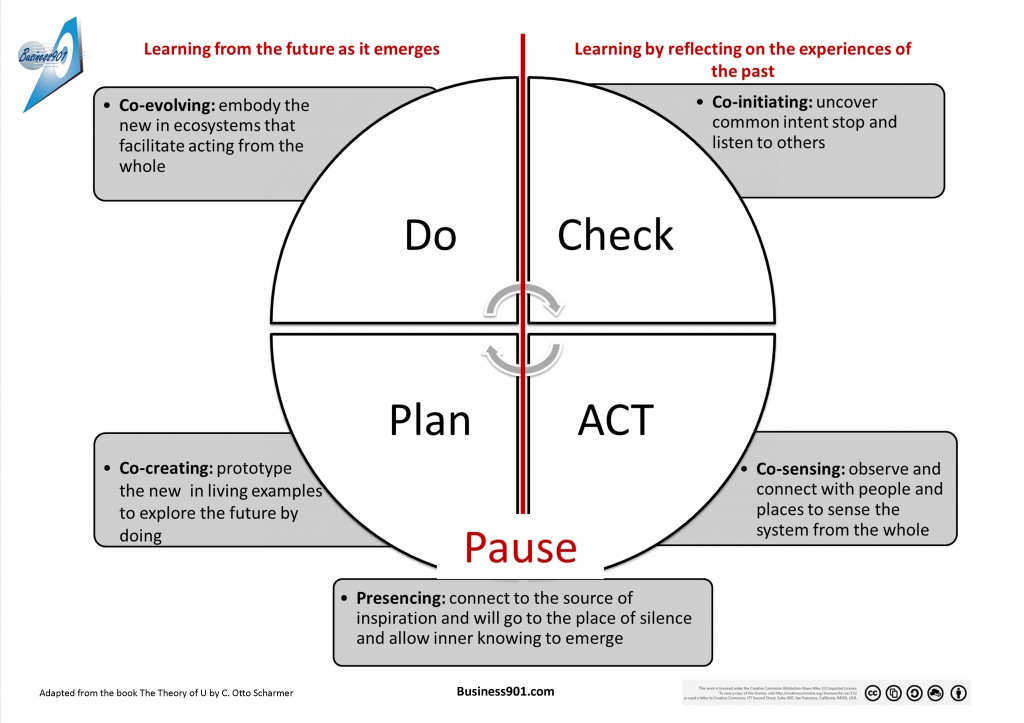In past blogs, I discuss using CAPD (Check – Act – Plan – Do) or CAP- Do as the beginning cycle for Lean Sales and Marketing. It was term popularized by many that were directly influenced by Dr. Deming, such as Brian Joiner and Yoji Akao. Even with the direct influence of those three I have struggled putting context around the Lean Marketing or Lean Sales conversation. This year, I have spent quite a bit of time reviewing Systems Thinking and there has not been a more profound effect on my thinking than C. Otto Scharmer’s work that he captured in the book, Theory U: Leading from the Future as It Emerges.
The Theory U, when applied to the CAP-Do cycle, does a remarkable job of explaining the shift required from internal thinking as an organization and moving to collective/external thinking. Scharmer calls this link the field structure of attention. What I like about the process is that it does not require you to throw away the old but by simply applying CAP-Do. In the Check/Plan stages, we are able to reflect and adjust our internal thinking and provides incremental improvement to our external world of the Act/Do stages.
In the book Scharmer says:
The essence of leadership is to shift the inner place from which we operate both individually and collectively.
The soil in my father’s fields ranges from shallow to deep. Likewise, in our social fields, there are fundamentally different layers (field structures) of attention, also varying from shallow to deep. The field structure of attention concerns the relationship between observer and observed. It concerns the quality of how we attend to the world. That quality differs depending on the place or position from which our attention originates relative to the organizational boundary of the observer and the observed. In my research that led to this book, I found that there are four different places or positions that each gives rise to a different quality or field structure of attention.
They are: (1) I-in-me: what I perceive based on my habitual ways of seeing and thinking, (2) I-in-it: what I perceive with my senses and mind wide open, (3) I-in-you: what I tune in to and sense from within with my heart wide open, and (4) I-in-now: what I understand from the source or the bottom of my being, that is, from attending with my open will. The four field structures differ in the place from which attention (and intention) originates: habits, open mind, open heart, and open will, respectively. Every action by a person, a leader, a group, an organization, or a community can be enacted in these four different ways.
Below is a graphical representation showing the Theory U applied to Cap-Do.
When we apply Lean to the sales and marketing, most practitioners think of improving processes from the element of cycle time or reducing waste. My thoughts of applying Lean center on developing deeper perception of customers and experiences they should have with us. It is the collective thought and how we develop that in our interactions. This is what makes Lean powerful. The CAP-Do cycle symbolizes this process. Lean Engagement teams face new challenges that are solved by collective thought. This collective thinking needs to be done internally, externally and across organizations. It will not come naturally and needs to be created and learned. Lean provides that opportunity.
Related Thoughts:
In Lean it’s not the Pivot, it’s the Pause that is important
A Lean Sales Conversation
Sales and Service Planning with PDCA
Lean Sales and Marketing approach to Productivity

Comments are closed.